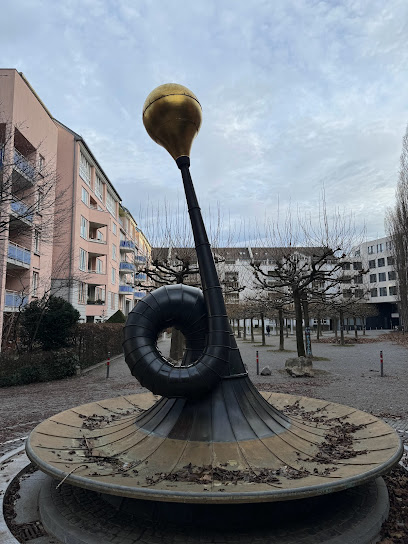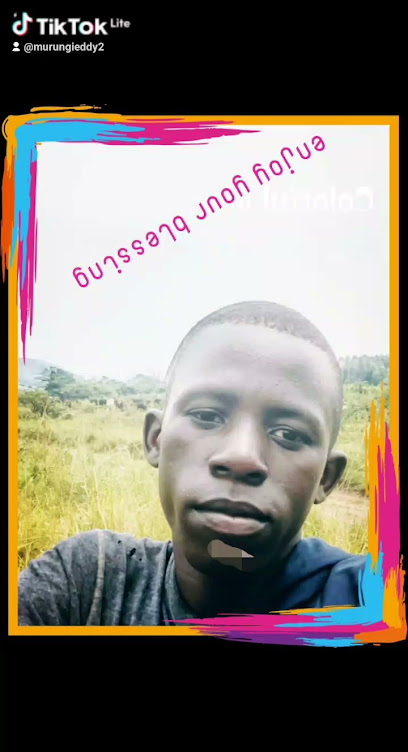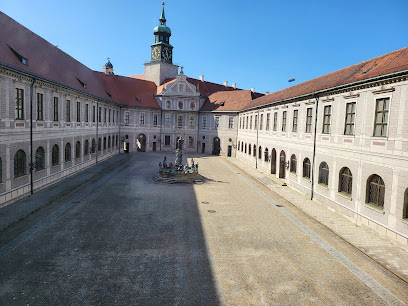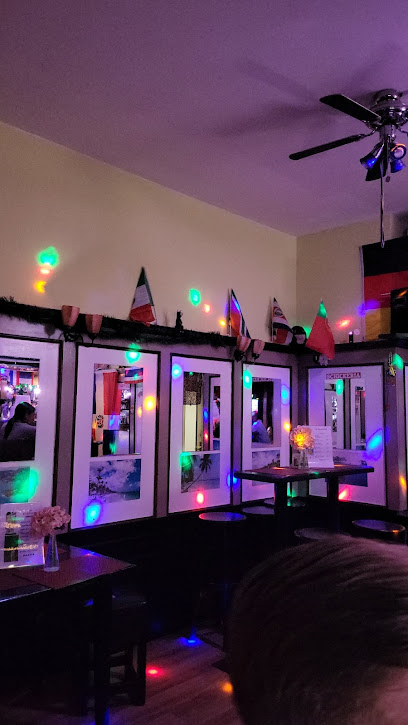
Haidhausen: Munich’s Enchanting Riverside Quarter
Discover Haidhausen: Munich’s picturesque riverside neighborhood, offering a blend of historical charm, cultural richness, and vibrant nightlife along the Isar River.
Nestled along the eastern banks of the Isar River, Haidhausen is a neighborhood that effortlessly blends the charm of old Munich with a vibrant, modern flair. Known for its picturesque streets lined with pastel-colored buildings and cozy cafes, Haidhausen is a delightful place for leisurely walks and explorations. Begin your journey at the bustling Wiener Platz, home to a lively market where locals gather for fresh produce and flowers. The square is surrounded by traditional Bavarian architecture, offering a perfect backdrop for photos. A short stroll will lead you to the historic Gasteig cultural center, a hub for music, theater, and art, ensuring that there is always something enriching to experience. For a taste of local history, visit the Maximilianeum, the seat of the Bavarian state parliament. Its impressive architecture and manicured gardens provide a serene escape from the city's hustle and bustle. If you’re visiting in the warmer months, take a leisurely bike ride along the river or enjoy a relaxing afternoon at one of the many beer gardens dotting the area, where you can savor traditional German brews and hearty cuisine. Haidhausen is also known for its thriving nightlife, with a plethora of bars and clubs that cater to all tastes. Whether you're looking for a quiet evening of jazz or a lively dance party, this neighborhood has it all. As a tourist destination, Haidhausen offers a unique blend of cultural richness, historical significance, and contemporary vibrancy, making it a must-visit spot in Munich.
Local tips in Haidhausen
- Visit early in the morning to enjoy the Wiener Platz market before it gets crowded.
- Rent a bike to explore the scenic paths along the Isar River.
- Check the schedule at the Gasteig cultural center for unique local performances.
- Take time to relax in one of the traditional beer gardens, especially during the summer.
Haidhausen: Munich’s Enchanting Riverside Quarter
Nestled along the eastern banks of the Isar River, Haidhausen is a neighborhood that effortlessly blends the charm of old Munich with a vibrant, modern flair. Known for its picturesque streets lined with pastel-colored buildings and cozy cafes, Haidhausen is a delightful place for leisurely walks and explorations. Begin your journey at the bustling Wiener Platz, home to a lively market where locals gather for fresh produce and flowers. The square is surrounded by traditional Bavarian architecture, offering a perfect backdrop for photos. A short stroll will lead you to the historic Gasteig cultural center, a hub for music, theater, and art, ensuring that there is always something enriching to experience. For a taste of local history, visit the Maximilianeum, the seat of the Bavarian state parliament. Its impressive architecture and manicured gardens provide a serene escape from the city's hustle and bustle. If you’re visiting in the warmer months, take a leisurely bike ride along the river or enjoy a relaxing afternoon at one of the many beer gardens dotting the area, where you can savor traditional German brews and hearty cuisine. Haidhausen is also known for its thriving nightlife, with a plethora of bars and clubs that cater to all tastes. Whether you're looking for a quiet evening of jazz or a lively dance party, this neighborhood has it all. As a tourist destination, Haidhausen offers a unique blend of cultural richness, historical significance, and contemporary vibrancy, making it a must-visit spot in Munich.
Iconic landmarks you can’t miss
Maximiliansanlagen
Explore the beauty and history of Maximiliansanlagen Park in Munich, a serene escape filled with lush landscapes and cultural treasures.

Friedensengel
Explore Friedensengel in Munich, a stunning historical landmark embodying peace, surrounded by lush gardens and scenic views.

Bordeauxplatz
Experience the beauty of Bordeauxplatz in Munich, a serene park perfect for relaxation, picnics, and enjoying nature's tranquility.

Rhein-Brunnen Fountain
Discover the enchanting Rhein-Brunnen Fountain in Munich's Au-Haidhausen, a serene oasis of beauty and tranquility perfect for tourists seeking relaxation.

Brunnen Weißenburger Platz
Explore Brunnen Weißenburger Platz, a serene historical landmark in Munich's Au-Haidhausen district, perfect for relaxation and cultural immersion.

Üblacker-Häusl
Explore the rich tapestry of Munich's history at Üblacker-Häusl, a charming local history museum and art gallery in Au-Haidhausen.

Georg Elser-Gedenktafel
Discover the Georg Elser-Gedenktafel in Munich, a historical landmark honoring the courageous act of defiance against tyranny during World War II.

Brunnenweibchen
Explore the beauty of Brunnenweibchen, Munich's historic fountain, offering serene ambiance and stunning sculptures in the heart of the city.

Glyzinien-Haus
Discover the architectural beauty and serene gardens of Glyzinien-Haus, a tranquil tourist attraction in Munich's historic Au-Haidhausen district.

Glaspalast-Brunnen
Discover the captivating Glaspalast-Brunnen in Munich, a serene fountain showcasing stunning art and a perfect spot for relaxation amidst the city's vibrant atmosphere.

Unmissable attractions to see
Deutsches Museum
Explore the wonders of science and technology at the Deutsches Museum in Munich, the world's largest museum dedicated to innovation and human ingenuity.

Munich Residenz
Discover the opulent history and architectural beauty of the Munich Residenz, a must-visit attraction in Germany's vibrant capital.

Frauenkirche
Explore the stunning Frauenkirche in Munich, a Gothic masterpiece with rich history, breathtaking architecture, and peaceful ambiance, perfect for every traveler.

Hofgarten
Discover the serene beauty of Hofgarten, Munich's historic park with lush landscapes, classical architecture, and a tranquil atmosphere.

Maximiliansanlagen
Discover the serene beauty of Maximiliansanlagen, Munich's lush park offering picturesque landscapes, walking paths, and tranquil river views.

Orleansplatz
Experience the vibrant culture and charming ambiance of Orleansplatz, a must-visit tourist attraction in Munich's Au-Haidhausen district.

Brunnenweibchen
Experience the charm of Brunnenweibchen, a historic fountain in Munich that beautifully blends art and nature in a serene urban setting.

Paulanerbrunnen
Experience the serene beauty of Paulanerbrunnen, a charming fountain in Munich that offers a perfect blend of relaxation and cultural history.

Rusticana
Experience the best of Bavarian cuisine and hospitality at Rusticana, a hidden gem in Munich's Au-Haidhausen district.

Essential places to dine
Nana – Meze & Wine
Experience authentic Israeli cuisine at Nana – Meze & Wine in Munich’s Au-Haidhausen district; where every dish tells a story.

spicery
Experience authentic Thai cuisine at Spicery in Munich's Au-Haidhausen district, where every dish tells a flavorful story.

Chez Fritz
Discover the flavors of France at Chez Fritz - Munich's exquisite brasserie offering elegant dining experiences.

Spezlwirtschaft
Discover authentic Bavarian flavors at Spezlwirtschaft in Munich’s Au-Haidhausen - where tradition meets modern dining.

metz7 Restaurant essen&trinken
Experience authentic Italian flavors in Munich at Metz7 Restaurant, where every dish is crafted with passion and tradition.

Restaurant Atelier Gourmet
Experience exquisite French cuisine at Restaurant Atelier Gourmet in Munich's vibrant Au-Haidhausen district.

POLKA Restaurant
Experience innovative healthy cuisine at POLKA Restaurant in Munich's Au-Haidhausen district – where flavor meets wellness.

Farmer & Lou
Experience culinary excellence at Farmer & Lou in Munich – where local flavors meet global cuisine in an inviting atmosphere.

KLIMENTI'S Restaurant
Savor authentic Mediterranean cuisine at KLIMENTI'S Restaurant in Munich - where flavor meets tradition.

JAMS Restaurant & Bar
Experience the best of Western cuisine at JAMS Restaurant & Bar in Munich's lively Au-Haidhausen district, perfect for food lovers and nightlife seekers alike.

Markets, malls and hidden boutiques
Boutique Domination
Explore Boutique Domination in Munich for unique fashion pieces that elevate your style and offer a personalized shopping experience.

hide[m]
Explore the chic hide[m] boutique in Munich for exclusive men's and women's fashion, embodying style and sophistication in every piece.
![hide[m]](https://evendo-location-media.s3.amazonaws.com/ShoppingImages/83e7e23c-c9cf-498a-b838-3530e98e2767)
Oxfam Fashionshop München-Haidhausen
Explore Oxfam Fashionshop in Munich for unique, eco-friendly clothing and accessories while supporting a noble cause.

The Lovely Concept
Discover unique fashion accessories and stylish clothing at The Lovely Concept, Munich's premier shopping destination for fashion enthusiasts.

Weltladen München
Explore the charm of Weltladen München, your destination for unique gifts, fashion accessories, and fair-trade finds in the heart of Munich.

Doppler Shop München
Explore Doppler Shop München for unique gifts and local treasures that embody the spirit of Munich, perfect for any traveler seeking memorable souvenirs.

HIER-Store
Explore HIER-Store in Munich for a unique shopping experience with stylish clothing and accessories that embody local fashion trends.

Ypnotic
Explore Munich's fashion scene at Ypnotic, a unique clothing store in the heart of Au-Haidhausen, offering trendy apparel and accessories.

Hands Gallery
Explore Hands Gallery in Munich, a treasure trove of unique handmade gifts, jewelry, and baby items that capture the essence of Bavarian craftsmanship.

Vintage Etcetera
Explore Vintage Etcetera in Munich - A Boutique of Unique Vintage Clothing and Home Decor Treasures.

Essential bars & hidden hideouts
Tap-House
Experience Munich's vibrant beer culture at Tap-House, a brewpub offering an extensive selection of craft beers and delicious pub fare.

Leo's Lounge | Mexican - Deutsch Restaurant & Cocktailbar
Discover the vibrant fusion of Mexican and German flavors at Leo's Lounge, Munich's premier restaurant and cocktail bar.

Negroni Bar
Discover the art of mixology at Negroni Bar, Munich's top cocktail destination blending style, flavor, and a vibrant atmosphere.

Barroom
Experience the art of mixology in Munich's Barroom, where delicious cocktails and an elegant atmosphere await every night.

Vivo
Discover the vibrant atmosphere and delicious offerings at Vivo, a top bar and restaurant in Munich's Au-Haidhausen district.

Juliet Rose Bar
Discover the enchanting Juliet Rose Bar in Munich, where exquisite cocktails meet a vibrant atmosphere for an unforgettable night out.

Bar 360 ° Cocktail Lounge
Discover the ultimate cocktail experience at Bar 360° Cocktail Lounge in Munich, where creativity meets a cozy atmosphere and exceptional service.

The Red Button
Discover The Red Button, a charming bar and beer garden in Munich's Au-Haidhausen, perfect for sampling local brews and enjoying a lively atmosphere.

La Bodeguita - cocktail Bar München
Discover Munich's vibrant cocktail scene at La Bodeguita, where creative drinks meet a lively atmosphere in the heart of Au-Haidhausen.

Polka Bar
Discover Munich's Polka Bar – a lively nightlife hotspot serving exquisite cocktails in a cozy, welcoming atmosphere.

Local Phrases
-
- HelloHallo
[ha-lo] - GoodbyeAuf Wiedersehen
[ouf vee-der-zay-en] - YesJa
[ya] - NoNein
[nine] - Please/You're welcomeBitte
[bi-te] - Thank youDanke
[dahn-ke] - Excuse me/SorryEntschuldigung
[ent-shool-di-gung] - How are you?Wie geht es dir?
[vee geht es deer] - Fine. And you?Gut. Und dir?
[goot oont deer] - Do you speak English?Sprechen Sie Englisch?
[shpre-khen zee eng-lish] - I don't understandIch verstehe nicht
[ikh fer-shtay-eh nikht]
- HelloHallo
-
- I'd like to see the menu, pleaseIch würde gerne die Speisekarte sehen, bitte
[ikh vur-de geh-ren-eh dee shpy-ze-kar-teh zay-en, bi-teh] - I don't eat meatIch esse kein Fleisch
[ikh es-seh kine fly-sh] - Cheers!Prost!
[prohst] - I would like to pay, pleaseIch würde gerne zahlen, bitte
[ikh vur-de geh-ren-eh tsah-len, bi-teh]
- I'd like to see the menu, pleaseIch würde gerne die Speisekarte sehen, bitte
-
- Help!Hilfe!
[hil-feh] - Go away!Geh weg!
[geh vehg] - Call the Police!Rufen Sie die Polizei!
[roo-fen zee dee po-lee-tsai] - Call a doctor!Rufen Sie einen Arzt!
[roo-fen zee i-nen ahrts] - I'm lostIch habe mich verloren
[ikh hah-beh meeh fer-lo-ren] - I'm illIch bin krank
[ikh bin krank]
- Help!Hilfe!
-
- I'd like to buy...Ich möchte kaufen...
[ikh mehrk-teh kow-fen] - I'm just lookingIch schaue nur
[ikh shou-eh noor] - How much is it?Wie viel kostet es?
[vee feel kow-stet es] - That's too expensiveDas ist zu teuer
[dahs ist tso toy-er] - Can you lower the price?Kannst du den Preis senken?
[kahnst doo den prees sen-ken]
- I'd like to buy...Ich möchte kaufen...
-
- What time is it?Wie spät ist es?
[vee shpet ist es] - It's one o'clockEs ist ein Uhr
[es ist iyn oor] - Half past (10)Halb (10)
[halb] - MorningMorgen
[mohr-gen] - AfternoonNachmittag
[nahkh-mee-tahg] - EveningAbend
[ah-bent] - YesterdayGestern
[gehs-tern] - TodayHeute
[hoi-teh] - TomorrowMorgen
[mohr-gen] - 1Eins
[ayns] - 2Zwei
[tsvai] - 3Drei
[dry] - 4Vier
[feer] - 5Fünf
[foonf] - 6Sechs
[zeks] - 7Sieben
[zee-ben] - 8Acht
[ahkt] - 9Neun
[noyn] - 10Zehn
[tsayn]
- What time is it?Wie spät ist es?
-
- Where's a/the...?Wo ist ein/der...?
[vo ist iyn/der] - What's the address?Was ist die Adresse?
[vas ist dee ah-dreh-say] - Can you show me (on the map)?Können Sie mir zeigen (auf der Karte)?
[kern-en zee meer tsai-gen (ouf der kar-teh)] - When's the next (bus)?Wann kommt der nächste (Bus)?
[vahn kohmt der neh-khste (boos)] - A ticket (to ....)Eine Fahrkarte (nach ....)
[i-ne fahr-kar-teh (nakh)]
- Where's a/the...?Wo ist ein/der...?
History of Haidhausen
-
Haidhausen's history dates back to the early Middle Ages, with its name derived from the Old High German word 'Haid,' meaning 'heath.' Initially a rural area, it became a settlement due to its proximity to the River Isar, which provided essential resources and transport routes. The village was first mentioned in historical records in 1231.
-
In 1854, Haidhausen was incorporated into the city of Munich, marking a significant transition from a separate village to an integral part of the growing urban center. This integration brought about infrastructure improvements, including the development of the railway, which connected Haidhausen more closely to central Munich and facilitated its expansion.
-
The latter half of the 19th century saw Haidhausen transformed by a wave of architectural development. This period introduced many residential buildings in the Gründerzeit style, characterized by ornate facades and intricate details. The construction of the Gasteig cultural center in the late 20th century further solidified Haidhausen's status as a cultural hub within Munich.
-
Haidhausen is often referred to as the 'Münchner Freiheit,' reflecting its vibrant cultural scene. The neighborhood became a focal point for artists, musicians, and writers, particularly during the late 19th and early 20th centuries. The influence of the nearby Munich Conservatory established Haidhausen as a center for music and the arts, fostering a rich cultural heritage that persists today.
-
Haidhausen, like much of Munich, suffered significant damage during World War II. Post-war reconstruction efforts led to a blend of the old and the new, as historical buildings were restored while modern architecture was introduced. This reconstruction shaped the character of Haidhausen, balancing its historical roots with contemporary urban living.
-
Today, Haidhausen is known for its unique blend of traditional Bavarian culture and modern urban lifestyle. The neighborhood is characterized by lively squares, traditional beer gardens, and trendy cafes, attracting both locals and tourists. Events like the annual Haidhausen Street Festival celebrate its rich history while embracing contemporary culture, making it a dynamic part of Munich.
Haidhausen Essentials
-
Haidhausen is well-connected to the rest of Munich via public transportation. To reach Haidhausen from central Munich, take the S-Bahn (S2, S4, S6, S8) to Ostbahnhof or the U-Bahn (U2) to Sendlinger Tor followed by a short tram ride (Tram 19) to the area. Trains run frequently and provide a quick and efficient means of travel.
-
Haidhausen is easily navigable by foot, with many attractions located within walking distance. For longer distances, the public transport system, including trams (Tram 19, 20) and buses (Bus 54), is reliable and efficient. Bicycles can also be rented from various bike-sharing services available throughout Munich, making it a great option for exploring the neighborhood.
-
Haidhausen is generally a safe neighborhood for tourists, but it is wise to remain vigilant in crowded areas, especially around bars and nightlife spots. Avoid walking alone late at night in less busy streets, and keep an eye on your belongings in crowded places. Petty crimes like pickpocketing can occur, so practice standard safety precautions.
-
In case of an emergency, dial 112 for police, fire, or medical assistance. Hospitals and medical clinics are available throughout Haidhausen. It is advisable to have travel insurance that covers emergencies. For minor ailments, local pharmacies are well-stocked with over-the-counter medications.
-
Fashion: Do dress comfortably and consider the local climate. Avoid overly casual attire in upscale restaurants. Religion: Do respect local traditions and customs. When visiting churches, dress modestly. Public Transport: Do give up your seat for elderly passengers. Don't eat or drink on public transport. Greetings: Do greet with a friendly 'Hallo' or 'Guten Tag'. Avoid overly casual greetings. Eating & Drinking: Do try local dishes and enjoy beer gardens. Don't waste food, as it is considered disrespectful.
-
To experience Haidhausen like a local, visit the weekly markets held at Wiener Platz, where you can find fresh produce and artisan goods. Explore the charming streets of the neighborhood, particularly the colorful houses on Pariser Strasse. Engage with locals in cafes and bakeries, as they often have fascinating stories about the area’s history. Don't miss the chance to visit the Gasteig cultural center for concerts and events.
Nearby Cities to Haidhausen
-
Things To Do in Kitzbühel
-
Things To Do in Innsbruck
-
Things To Do in Salzburg
-
Things To Do in Zell am See
-
Things To Do in St. Anton am Arlberg
-
Things To Do in Nuremberg
-
Things To Do in Bregenz
-
Things To Do in Dornbirn
-
Things To Do in Bad Gastein
-
Things To Do in Hallstatt
-
Things To Do in Rothenburg ob der Tauber
-
Things To Do in Schellenberg
-
Things To Do in Ruggell
-
Things To Do in Mauren
-
Things To Do in Eschen










